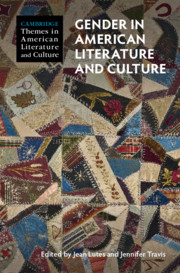Book contents
- Gender in American Literature and Culture
- Cambridge Themes in American Literature and Culture
- Gender in American Literature and Culture
- Copyright page
- Contents
- Contributors
- Acknowledgments
- Introduction
- Part I Intimacies
- Part II Aggressions
- Part III New Directions
- Chapter 15 What a Doctor Should Look Like
- Chapter 16 Genderqueer
- Chapter 17 Fanfiction, Transformative Works, and Feminist Resistance in Digital Culture
- Chapter 18 Vulnerable States
- Chapter 19 The Mahjar
- Chapter 20 Disabled Women’s Life Writing and the Problem with Recovery
- Chapter 21 Feeling, Memory, and Peoplehood in Contemporary Native Women’s Poetry
- Bibliography
- Index
Chapter 15 - What a Doctor Should Look Like
Queer Femme Erasure and the Politics of Dress in the Nineteenth Century
from Part III - New Directions
Published online by Cambridge University Press: 01 April 2021
- Gender in American Literature and Culture
- Cambridge Themes in American Literature and Culture
- Gender in American Literature and Culture
- Copyright page
- Contents
- Contributors
- Acknowledgments
- Introduction
- Part I Intimacies
- Part II Aggressions
- Part III New Directions
- Chapter 15 What a Doctor Should Look Like
- Chapter 16 Genderqueer
- Chapter 17 Fanfiction, Transformative Works, and Feminist Resistance in Digital Culture
- Chapter 18 Vulnerable States
- Chapter 19 The Mahjar
- Chapter 20 Disabled Women’s Life Writing and the Problem with Recovery
- Chapter 21 Feeling, Memory, and Peoplehood in Contemporary Native Women’s Poetry
- Bibliography
- Index
Summary
The queer femme disrupts the legibility of queerness and politics since the feminine is scapegoated for its subjugation as false and inferior. This essay explores the cultural genealogy of queer femme invisibility by reading white women physician characters in late nineteenth-century New Woman novels in relation to the science of sexology and feminist dress reform as contrapuntal forces that informed the viability of gender expression. Henry James’s The Bostonians, Elizabeth Stuart Phelps’s Doctor Zay, Sarah Orne Jewett’s A Country Doctor, and William Dean Howells’s Dr. Breen’s Practice present variations on the cultural dichotomy between femme and science framed by the marriage plot. Through the politics of dress the possibility of the queer femme is both acknowledged and erased as a legitimate expression and valid identity. These novels trace an incipient femme sensibility bound to whiteness that disrupts assumptions about the coherence of representation required for viability of minoritarian gender identities.
Keywords
- Type
- Chapter
- Information
- Gender in American Literature and Culture , pp. 237 - 254Publisher: Cambridge University PressPrint publication year: 2021

